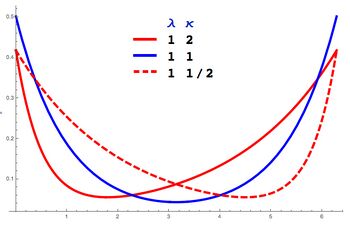Wrapped asymmetric Laplace distribution
|
Probability density function  Wrapped asymmetric Laplace PDF with m = 0.Note that the κ = 2 and 1/2 curves are mirror images about θ=π | |||
| Parameters |
[math]\displaystyle{ m }[/math] location [math]\displaystyle{ ( 0 \le m \lt 2 \pi ) }[/math] | ||
|---|---|---|---|
| Support | [math]\displaystyle{ 0\le\theta\lt 2\pi }[/math] | ||
| (see article) | |||
| Mean | [math]\displaystyle{ m }[/math] (circular) | ||
| Variance | [math]\displaystyle{ 1-\frac{\lambda ^2}{\sqrt{\left(\frac{1}{\kappa ^2}+\lambda^2 \right) \left(\kappa ^2+\lambda ^2\right)}} }[/math] (circular) | ||
| CF | [math]\displaystyle{ \frac{\lambda^2 e^{i m n}}{\left(n-i \lambda/\kappa \right) \left(n+i \lambda\kappa \right)} }[/math] | ||
In probability theory and directional statistics, a wrapped asymmetric Laplace distribution is a wrapped probability distribution that results from the "wrapping" of the asymmetric Laplace distribution around the unit circle. For the symmetric case (asymmetry parameter κ = 1), the distribution becomes a wrapped Laplace distribution. The distribution of the ratio of two circular variates (Z) from two different wrapped exponential distributions will have a wrapped asymmetric Laplace distribution. These distributions find application in stochastic modelling of financial data.
Definition
The probability density function of the wrapped asymmetric Laplace distribution is:[1]
- [math]\displaystyle{ \begin{align} f_{WAL}(\theta;m,\lambda,\kappa) & =\sum_{k=-\infty}^\infty f_{AL}(\theta+2 \pi k,m,\lambda,\kappa) \\[10pt] & = \dfrac{\kappa\lambda}{\kappa^2+1} \begin{cases} \dfrac{e^{-(\theta-m)\lambda\kappa}} {1-e^{-2\pi\lambda\kappa}}- \dfrac{e^{(\theta-m)\lambda/\kappa}} {1-e^{2\pi\lambda/\kappa}} & \text{if } \theta \geq m \\[12pt] \dfrac{e^{-(\theta-m)\lambda\kappa}} {e^{2 \pi \lambda\kappa}-1}- \dfrac{e^{ (\theta-m)\lambda/\kappa}} {e^{-2\pi\lambda/\kappa }-1} & \text{if }\theta\lt m \end{cases} \end{align} }[/math]
where [math]\displaystyle{ f_{AL} }[/math] is the asymmetric Laplace distribution. The angular parameter is restricted to [math]\displaystyle{ 0 \le \theta \lt 2\pi }[/math]. The scale parameter is [math]\displaystyle{ \lambda \gt 0 }[/math] which is the scale parameter of the unwrapped distribution and [math]\displaystyle{ \kappa \gt 0 }[/math] is the asymmetry parameter of the unwrapped distribution.
The cumulative distribution function [math]\displaystyle{ F_{WAL} }[/math] is therefore:
- [math]\displaystyle{ F_{WAL}(\theta;m,\lambda,\kappa)=\dfrac{\kappa\lambda}{\kappa^2+1} \begin{cases} \dfrac{e^{m\lambda\kappa}(1-e^{-\theta\lambda\kappa})}{\lambda\kappa(e^{2\pi\lambda\kappa}-1)}+\dfrac{\kappa e^{-m\lambda/\kappa}(1-e^{\theta\lambda/\kappa})}{\lambda(e^{-2\pi\lambda/\kappa}-1)} & \text{if }\theta \leq m\\ \dfrac{1-e^{-(\theta-m)\lambda\kappa}}{\lambda\kappa(1-e^{-2\pi\lambda\kappa})}+\dfrac{\kappa(1-e^{(\theta-m)\lambda/\kappa})}{\lambda(1-e^{2\pi\lambda/\kappa})}+\dfrac{e^{m\lambda\kappa}-1}{\lambda\kappa(e^{2\pi\lambda\kappa}-1)}+\dfrac{\kappa(e^{-m\lambda/\kappa}-1)}{\lambda(e^{-2\pi\lambda/\kappa}-1)} &\text{if } \theta \gt m \end{cases} }[/math]
Characteristic function
The characteristic function of the wrapped asymmetric Laplace is just the characteristic function of the asymmetric Laplace function evaluated at integer arguments:
- [math]\displaystyle{ \varphi_n(m,\lambda,\kappa)=\frac{\lambda^2 e^{i m n}}{\left(n-i \lambda/\kappa \right) \left(n+i \lambda\kappa \right)} }[/math]
which yields an alternate expression for the wrapped asymmetric Laplace PDF in terms of the circular variable z=ei(θ-m) valid for all real θ and m:
- [math]\displaystyle{ \begin{align} f_{WAL}(z;m,\lambda,\kappa) &= \frac{1}{2\pi}\sum_{n=-\infty}^\infty \varphi_n(0,\lambda,\kappa)z^{-n} \\[10pt] &= \frac{\lambda}{\pi(\kappa+1/\kappa)} \begin{cases} \textrm{Im}\left(\Phi (z,1,-i \lambda\kappa )-\Phi \left(z,1,i \lambda /\kappa \right)\right)-\frac{1}{2 \pi } & \text{if }z \ne 1 \\[12pt] \coth(\pi\lambda\kappa)+\coth(\pi\lambda/\kappa) & \text{if }z=1 \end{cases} \end{align} }[/math]
where [math]\displaystyle{ \Phi() }[/math] is the Lerch transcendent function and coth() is the hyperbolic cotangent function.
Circular moments
In terms of the circular variable [math]\displaystyle{ z=e^{i\theta} }[/math] the circular moments of the wrapped asymmetric Laplace distribution are the characteristic function of the asymmetric Laplace distribution evaluated at integer arguments:
- [math]\displaystyle{ \langle z^n\rangle=\varphi_n(m,\lambda,\kappa) }[/math]
The first moment is then the average value of z, also known as the mean resultant, or mean resultant vector:
- [math]\displaystyle{ \langle z \rangle =\frac{\lambda^2 e^{i m}}{\left(1-i \lambda/\kappa \right) \left(1+i \lambda\kappa \right)} }[/math]
The mean angle is [math]\displaystyle{ (-\pi \le \langle \theta \rangle \leq \pi) }[/math]
- [math]\displaystyle{ \langle \theta \rangle=\arg(\,\langle z \rangle\,)=\arg(e^{i m}) }[/math]
and the length of the mean resultant is
- [math]\displaystyle{ R=|\langle z \rangle| = \frac{\lambda ^2}{\sqrt{\left(\frac{1}{\kappa ^2}+\lambda^2 \right) \left(\kappa ^2+\lambda ^2\right)}}. }[/math]
The circular variance is then 1 − R
Generation of random variates
If X is a random variate drawn from an asymmetric Laplace distribution (ALD), then [math]\displaystyle{ Z=e^{i X} }[/math] will be a circular variate drawn from the wrapped ALD, and, [math]\displaystyle{ \theta=\arg(Z)+\pi }[/math] will be an angular variate drawn from the wrapped ALD with [math]\displaystyle{ 0\lt \theta\leq 2 \pi }[/math].
Since the ALD is the distribution of the difference of two variates drawn from the exponential distribution, it follows that if Z1 is drawn from a wrapped exponential distribution with mean m1 and rate λ/κ and Z2 is drawn from a wrapped exponential distribution with mean m2 and rate λκ, then Z1/Z2 will be a circular variate drawn from the wrapped ALD with parameters ( m1 - m2 , λ, κ) and [math]\displaystyle{ \theta=\arg(Z_1/Z_2)+\pi }[/math] will be an angular variate drawn from that wrapped ALD with [math]\displaystyle{ -\pi\lt \theta\leq \pi }[/math].
See also
References
- ↑ Jammalamadaka, S. Rao; Kozubowski, Tomasz J. (2004). "New Families of Wrapped Distributions for Modeling Skew Circular Data". Communications in Statistics – Theory and Methods 33 (9): 2059–2074. doi:10.1081/STA-200026570. http://www.pstat.ucsb.edu/faculty/jammalam/html/Some%20Publications/2004_WrappedSkewFamilies_Comm..pdf. Retrieved 2011-06-13.
 |

